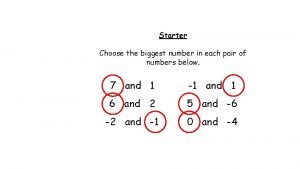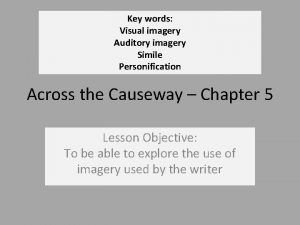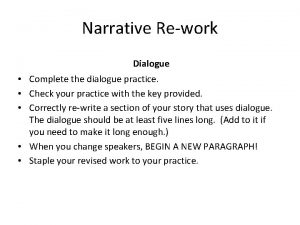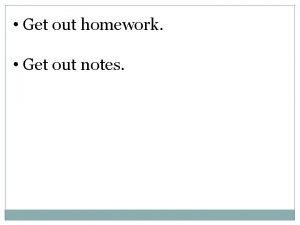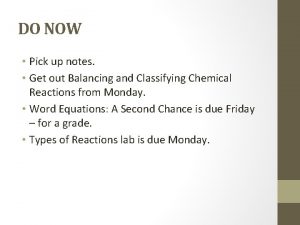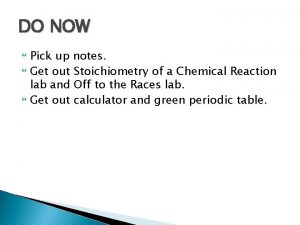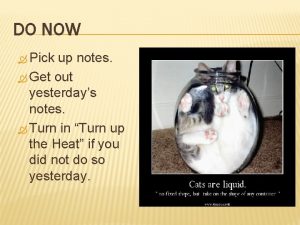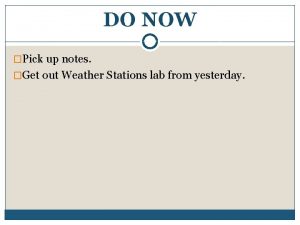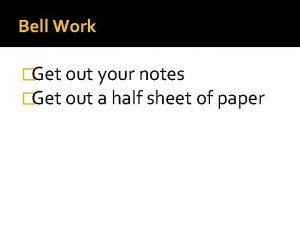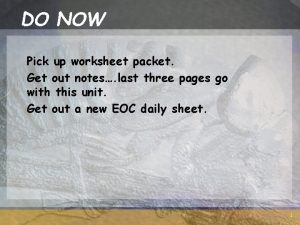DO NOW Pick up notes Get out homework



















- Slides: 19

DO NOW Pick up notes ¡ Get out homework handout ¡

MENDELEEV’S PERIODIC TABLE

A REVIEW Be sure that you can: 1. Describe the development of the modern periodic table (Mendeleev and Moseley only). 2. State the Periodic Law. 3. Be able to describe elements by their: period valence electrons electron configuration 4. Recognize the divisions of the periodic table into an ‘s’ block, ‘p’ block, ‘d’ block, and ‘f’ block. 5. Be able to predict and write the electron configuration of an element using the periodic table as a guide.

THE PERIODIC LAW The physical and chemical properties of the elements are periodic functions of their atomic numbers. Memorize this!

ANOTHER WAY TO LOOK AT THE TABLE All elements can be divided into three groups: METALS NONMETALS METALLOIDS

METALS

METALS ¡ ¡ ¡ ¡ located on the left side. good conductors of heat and electricity. hard and shiny (not always silver) can be pounded into different shapes – malleable. can be drawn into a wire – ductile. high density, high melting points react with water and substances in the atmosphere (ex. rusting, tarnishing).

METALS ¡ ¡ has only a few electrons in the outer level most elements are metallic. General rule: - 3 or fewer electrons in outer level are considered to be metals. - Metals have a tendency to lose these electrons when forming compounds.

NONMETALS

NONMETALS ¡ ¡ ¡ located on the right side (except hydrogen). poor conductors of heat and electricity (solids are insulators). brittle solids or gases; one liquid. dull, shatter easily. lower density, lower melting points. not as easy to recognize as a group.

NONMETALS ¡ has more than 4 electrons in the outer level. General rule: - 5 or more electrons in outer level are considered to be nonmetals. - Nonmetals have a tendency to gain electrons when forming compounds.

METALLOIDS Debatable

METALLOIDS have properties of metals and nonmetals. ¡ metal-like ¡ Sometimes called semi-metals. ¡ located on either side of the staircase. ¡ all are shiny, white-gray in color. ¡ all are solids. ¡ okay conductors (as in semiconductors), ductile, malleable. ¡

METALLOIDS There are six: Boron, Silicon, Germanium, Arsenic, Antimony, Tellurium Aluminum, Polonium (debatable), and Astatine are NOT.

PERIODIC TABLE

WAYS TO DIVIDE UP THE PERIODIC TABLE 1. 2. 3. 4. 5. Period numbers Group numbers Family names Metal, nonmetal, metalloids Phases at room temperature (natural or standard state) ¡ There are 2 liquids: mercury and bromine. ¡ There are 11 gases. ¡ The rest are solids.

WAYS TO DIVIDE UP THE PERIODIC TABLE 6. Representative elements and Transition (inner) elements They are called the representative elements because they display a wide range of physical and chemical properties.

A REVIEW 3. Be able to describe elements by their: metal/nonmetal/metalloid

HOMEWORK The Periodic Law is due tomorrow. ¡ Lab tomorrow. ¡
 Shot me out of the sky you're my kryptonite meaning
Shot me out of the sky you're my kryptonite meaning Get into get out of
Get into get out of What are pick up notes
What are pick up notes Food chain of rabbit
Food chain of rabbit Pick out the greater number in each pair
Pick out the greater number in each pair Personification keywords
Personification keywords Choose the correct option p3m n4j r3p
Choose the correct option p3m n4j r3p Jack prelutsky homework oh homework
Jack prelutsky homework oh homework Homework oh homework i hate you you stink
Homework oh homework i hate you you stink Parts of a poem
Parts of a poem Jack prelutsky homework oh homework
Jack prelutsky homework oh homework Alitteration definition
Alitteration definition Literal language examples
Literal language examples Now i see it now you don't
Now i see it now you don't Now you know why i couldn't wait to get here said esteban
Now you know why i couldn't wait to get here said esteban Somebody once asked could i spare some change for gas
Somebody once asked could i spare some change for gas Confirm your email now and get 5 minutes as a gift!
Confirm your email now and get 5 minutes as a gift! Get up get moving quiz
Get up get moving quiz Get up get moving quiz
Get up get moving quiz Get up get moving
Get up get moving




